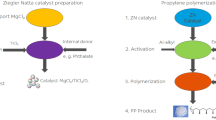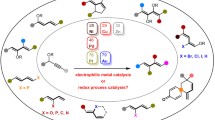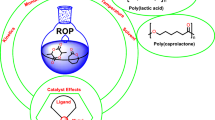Abstract
(R)-(−)-1,1′-Binaphthyl-2,2′-diyl hydrogen phosphate (BPA) has been demonstrated as an efficient organocatalyst for controlled ring-opening homopolymerization of ε-caprolactone (ε-CL) and copolymerization of ε-CL with glycolide and lactide. High molar mass PCL with narrow molar mass distribution has also been synthesized from the bulk ring-opening polymerization (ROP) of ε-CL with BPA as catalysts; the highest molar mass of PCL is 4.35 × 104 g/mol with polydispersity index of 1.20. The successful synthesis of high molar mass PCL is attributed to the bifunctional activation mechanism for the ROP of ε-CL catalyzed by BPA. More interestingly, ppm level of BPA is sufficient to catalyze controlled ROP of ε-CL.











Similar content being viewed by others
References
Hayashi T (1994) Biodegradable polymers for biomedical uses. Prog Polym Sci 19:663–702
Albertsson AC, Varma IK (2003) Recent developments in ring opening polymerization of lactones for biomedical applications. Biomacromolecules 4:1466–1486
Woodruff MA, Hutmacher DW (2010) The return of a forgotten polymer-Polycaprolactone in the 21st century. Prog Polym Sci 35:1217–1256
Zhao W, Wang Y, Liu X, Chen X, Cui D, Chen EYX (2012) Protic compound mediated living cross-chain-transfer polymerization of rac-lactide: synthesis of isotactic (crystalline)-heterotactic (amorphous) stereomultiblock polylactide. Chem Commun 48:6375–6377
Mecerreyes D, Jerome R, Dubois P (1999) Novel macromolecular architectures based on aliphatic polyesters: relevance of the "coordination-insertion" ring-opening polymerization. Adv Polym Sci 147:1–59
Majerska K, Duda A, Penczek S (2000) Kinetics and mechanism of cyclic esters polymerisation initiated with tin(II) octoate, 4—Influence of proton trapping agents on the kinetics of epsilon-caprolactone and L, L-dilactide polymerisation. Macromol Rapid Commun 21:1327–1332
Labet M, Thielemans W (2009) Synthesis of polycaprolactone: a review. Chem Soc Rev 38:3484–3504
Wang Y, Zhang LF, Wang P, Shen LJ (2010) Ring-opening polymerization of l-lactide with rare earth aryloxides substituted by various alkyl groups. Chin J Polym Sci 28:509–515
Sun JQ, Pan ZD, Yang SL (1998) Ring-opening polymerization of epsilon-caprolactone by lanthanocene catalysis. Chin J Polym Sci 16:297–303
Save M, Soum A (2002) Controlled ring-opening polymerization of Lactones and lactide initiated by lanthanum isopropoxide, 2—mechanistic studies. Macromol Chem Phys 203:2591–2603
Jerome C, Lecomte P (2008) Recent advances in the synthesis of aliphatic polyesters by ring-opening polymerization. Adv Drug Deliv Rev 60:1056–1076
Kiesewetter MK, Shin EJ, Hedrick JL, Waymouth RM (2010) Organocatalysis: opportunities and challenges for polymer synthesis. Macromolecules 43:2093–2107
Kamber NE, Jeong W, Waymouth RM, Pratt RC, Lohmeijer BGG, Hedrick JL (2007) Organocatalytic ring-opening polymerization. Chem Rev 107:5813–5840
Nederberg F, Connor EF, Moller M, Glauser T, Hedrick JL (2001) New paradigms for organic catalysts: The first organocatalytic living polymerization. Angew Chem Int Ed 40:2712–2715
Connor EF, Nyce GW, Myers M, Mock A, Hedrick JL (2002) First example of N-heterocyclic carbenes as catalysts for living polymerization: organocatalytic ring-opening polymerization of cyclic esters. J Am Chem Soc 124:914–915
Myers M, Connor EF, Glauser T, Mock A, Nyce G, Hedrick JL (2002) Phosphines: nucleophilic organic catalysts for the controlled ring-opening polymerization of lactides. J Polym Sci Part A: Polym Chem 40:844–851
Dove AP, Pratt RC, Lohmeijer BGG, Waymouth RM, Hedrick JL (2005) Thiourea-based bifunctional organocatalysis: supramolecular recognition for living polymerization. J Am Chem Soc 127:13798–13799
Gazeau-Bureau S, Delcroix D, Martin-Vaca B, Bonrissou D, Navarro C, Magnet S (2008) Organo-catalyzed ROP of epsilon-caprolactone: methanesulfonic acid competes with trifluoromethanesulfonic acid. Macromolecules 41:3782–3784
Shibasaki Y, Sanada H, Yokoi M, Sanda F, Endo T (2000) Activated monomer cationic polymerization of lactones and the application to well-defined block copolymer synthesis with seven-membered cyclic carbonate. Macromolecules 33:4316–4320
Persson PV, Schroder J, Wickholm K, Hedenstrom E, Iversen T (2004) Selective organocatalytic ring-opening polymerization: a versatile route to carbohydrate-functionalized poly(is an element of-caprolactones). Macromolecules 37:5889–5893
Casas J, Persson PV, Iversen T, Cordova A (2004) Direct organocatalytic ring-opening polymerizations of lactones. Adv Synth Catal 346:1087–1089
Kakuchi R, Tsuji Y, Chiba K, Fuchise K, Sakai R, Satoh T, Kakuchi T (2010) Controlled/living ring-opening polymerization of delta-valerolactone using triflylimide as an efficient cationic organocatalyst. Macromolecules 43:7090–7094
Sanda F, Sanada H, Shibasaki Y, Endo T (2002) Star polymer synthesis from epsilon-caprolactone utilizing polyol/protonic acid initiator. Macromolecules 35:680–683
Lou XD, Detrembleur C, Jerome R (2002) Living cationic polymerization of delta-valerolactone and synthesis of high molecular weight homopolymer and asymmetric telechelic and block copolymer. Macromolecules 35:1190–1195
Basko M, Kubisa P (2006) Cationic copolymerization of epsilon-caprolactone and L, L-lactide by an activated monomer mechanism. J Polym Sci A Polym Chem 44:7071–7081
Kim MS, Seo KS, Khang G, Lee HB (2005) Ring-opening polymerization of epsilon-caprolactone by poly(ethylene glycol) by an activated monomer mechanism. Macromol Rapid Commun 26:643–648
Basko M, Kubisa P (2007) Polyester oligodiols by cationic AM copolymerization of L, L-lactide and epsilon-caprolactone initiated by diols. J Polym Sci A Polym Chem 45:3090–3097
Athanasiou KA, Niederauer GG, Agrawal CM (1996) Sterilization, toxicity, biocompatibility, and clinical applications of polylactic acid/polyglycolic acid copolymers. Biomaterials 17:93–102
Gupta B, Revagade N, Hilborn J (2007) Poly(lactic acid) fiber: an overview. Prog Polym Sci 32:455–482
Jain RA (2000) The manufacturing techniques of various drug loaded biodegradable poly(lactide-co-glycolide) (PLGA) devices. Biomaterials 21:2475–2490
Ratner BD, Hoffman AS, Schoen FJ, Lemons JE (2004) Biomaterials science: an introduction to materials in medicine, 2nd edn. Elsevier Academic Press, Singapore
Dechy-Cabaret O, Martin-Vaca B, Bourissou D (2004) Controlled ring-opening polymerization of lactide and glycolide. Chem Rev 104:6147–6176
Bourissou D, Martin-Vaca B, Dumitrescu A, Graullier M, Lacombe F (2005) Controlled cationic polymerization of lactide. Macromolecules 38:9993–9998
Basko M, Kubisa P (2008) Mechanism of propagation in the cationic polymerization of L, L-Lactide. J Polym Sci A Polym Chem 46:7919–7923
Basko M, Kubisa P (2010) Cationic polymerization of L, L-Lactide. J Polym Sci A Polym Chem 48:2650–2658
Dechy-Cabaret O, Martin-Vaca B, Bourissou D (2004) Controlled ring-opening polymerization of lactide and glycolide. Chem Rev 104:6147–6176
Makiguchi K, Satoh T, Kakuchi T (2011) Diphenyl phosphate as an efficient cationic organocatalyst for controlled/living ring-opening polymerization of delta-valerolactone and epsilon-caprolactone. Macromolecules 44:1999–2005
Delcroix D, Couffin A, Susperregui N, Navarro C, Maron L, Martin-Vaca B, Bourissou D (2011) Phosphoric and phosphoramidic acids as bifunctional catalysts for the ring-opening polymerization of epsilon-caprolactone: a combined experimental and theoretical study. Polym Chem 2:2249–2256
Chen C, Xu R, Li B (2012) Controlled/living ring-opening polymerization of epsiv-caprolactone catalyzed by phosphoric acid. Sci China Chem 55:1257
Pratt RC, Lohmeijer BGG, Long DA, Waymouth RM, Hedrick JL (2006) Triazabicyclodecene: a simple bifunctional organocatalyst for acyl transfer and ring-opening polymerization of cyclic esters. J Am Chem Soc 128:4556–4557
Zhou SB, Xu JG, Yang H, Deng XM (2004) Synthesis and characterization of biodegradable poly(epsilon-caprolactone)-polyglycolide-poly(ethylene glycol) monomethyl ether random copolymer. Macromol Mater Eng 289:576–580
Yang H, Xu J, Pispas S, Zhang G (2012) Hybrid copolymerization of epsilon-caprolactone and methyl methacrylate. Macromolecules 45:3312–3317
Acknowledgments
This work is funded by the National Natural Science Foundation (NNSF) of China (21104020), the Ministry of Science and Technology of China (2012CB933802), and the Fundamental Research Funds for the Central Universities is greatly appreciated.
Author information
Authors and Affiliations
Corresponding author
Rights and permissions
About this article
Cite this article
Zhou, X., Hong, L. Controlled ring-opening polymerization of cyclic esters with phosphoric acid as catalysts. Colloid Polym Sci 291, 2155–2162 (2013). https://doi.org/10.1007/s00396-013-2950-9
Received:
Accepted:
Published:
Issue Date:
DOI: https://doi.org/10.1007/s00396-013-2950-9




